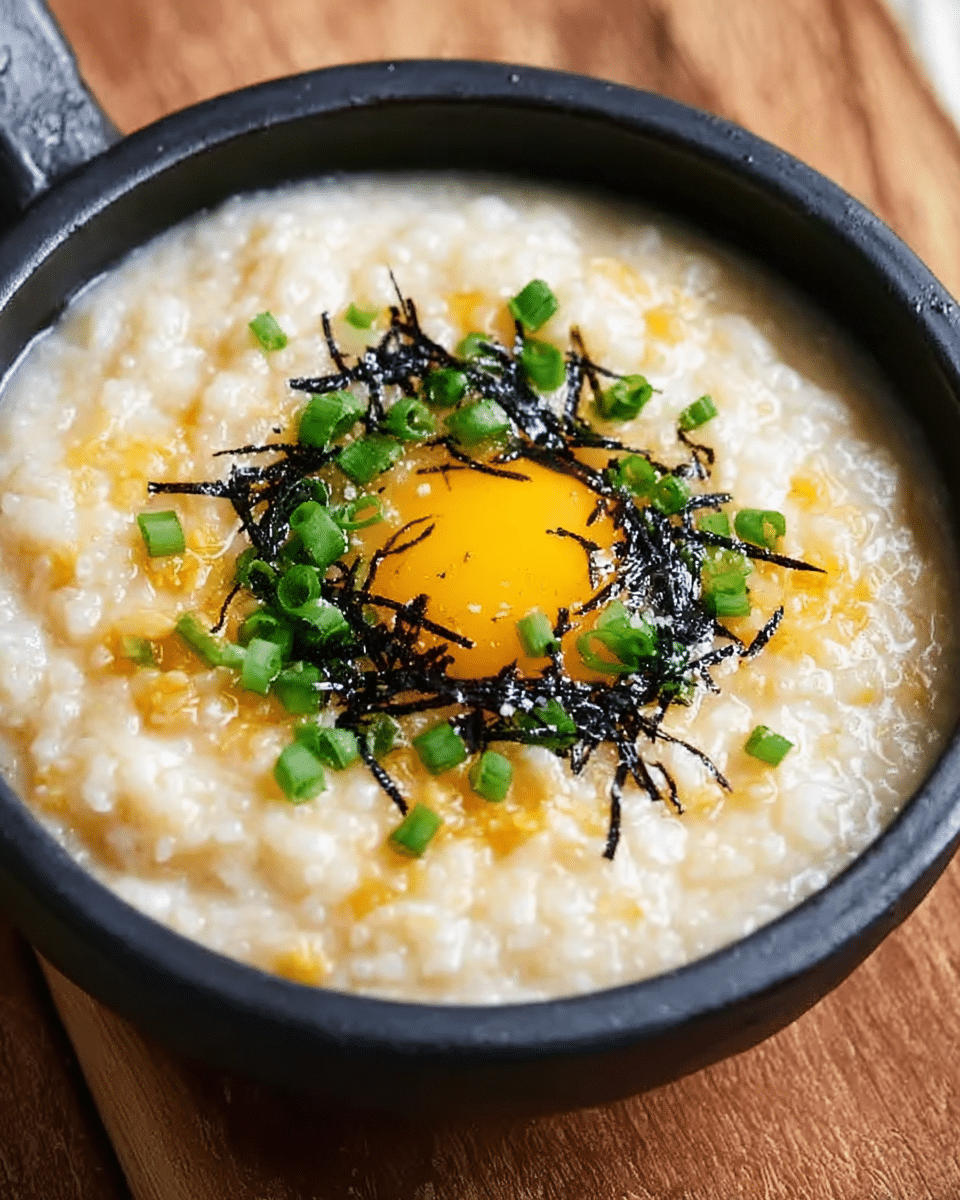Okayu is a comforting and simple Japanese rice porridge, perfect for when you’re feeling under the weather or craving something warm and soothing. This version is made with dashi stock, seasoned with sake, mirin, and light soy sauce, and topped with a whisked egg for added richness. It’s a light, nourishing dish that is easy to make and full of umami flavor, providing warmth and comfort in every bite.
Full Recipe:
Ingredients
-
200g cooked Japanese short-grain rice (about 1 cup)
-
2 medium eggs (or size of your choice)
-
400ml dashi stock (homemade or instant)
-
1 tsp sake (optional)
-
1 tsp mirin
-
1 tbsp light soy sauce (usuuchi shoyu)
-
1 tbsp finely chopped green onions (for garnish)
-
1 drizzle of toasted sesame oil (optional, for garnish)
-
2 tbsp kizami nori (shredded nori) (optional, for garnish)
Directions
-
Prepare the Dashi: Pour the dashi stock into a pot and bring it to a boil over medium heat.
-
Whisk the Egg: While waiting for the dashi to boil, whisk the eggs in a small bowl until well-combined.
-
Add Rice and Condiments: Once the dashi is boiling, add the cooked rice, sake, mirin, and light soy sauce. Stir and simmer the mixture, checking the consistency.
-
Simmer: Continue simmering with the lid slightly ajar. Stir occasionally and adjust the consistency to your liking—thicker the longer it cooks.
-
Add the Egg: Once the porridge reaches your desired consistency, pour the whisked egg into the pot. Wait for 20-30 seconds without stirring, then stir gently to break up the egg and distribute it throughout the porridge.
-
Serve: Transfer to serving bowls and top with toasted sesame oil, chopped green onions, and shredded nori, if using.
Nutrients
-
Calories: 256 kcal
-
Carbohydrates: 40.3g
-
Protein: 10.4g
-
Fat: 5.9g
-
Saturated Fat: 1.82g
-
-
Cholesterol: 204mg
-
Sodium: 748mg
-
Fiber: 1.6g
The Base of Okayu: Short-Grain Rice
The foundation of Okayu is Japanese short-grain rice, known for its sticky and slightly chewy texture when cooked. This rice variety absorbs liquids well, making it ideal for creating the soft and porridge-like consistency that defines Okayu. Short-grain rice contributes to the dish’s comforting texture and helps create a thick, creamy base once simmered in the dashi stock.
When making Okayu, it’s important to use cooked rice, typically leftovers from a previous meal. The rice should be soft, and the grains should have already been steamed to a fluffy texture. If you’re cooking rice fresh for the dish, make sure to let it cool a little before incorporating it into the dashi stock.
Dashi Stock: The Heart of Flavor
Dashi stock is the heart and soul of many Japanese dishes, and it’s essential in bringing out the umami flavor in Okayu. Dashi is typically made by simmering ingredients like kombu (dried kelp) and bonito flakes (dried fish flakes), creating a savory, slightly salty base that infuses the rice porridge with rich depth and complexity. Whether homemade or using instant dashi powder, the stock provides the key flavor profile that characterizes this comforting dish.
The beauty of dashi is its ability to complement the subtle flavor of rice without overwhelming it. The dashi stock brings a depth of flavor that serves as a canvas for the other ingredients, creating a harmonious balance. In this recipe, the dashi is further enhanced with the addition of sake, mirin, and light soy sauce, which contribute a mild sweetness and savory richness to the dish.
Seasoning the Okayu: Sake, Mirin, and Soy Sauce
Sake and mirin are essential ingredients in many Japanese dishes, and in Okayu, they help to elevate the flavor profile of the dish. Sake adds a slight depth of umami, while mirin contributes a touch of sweetness, balancing the saltiness of the soy sauce and the umami of the dashi. The soy sauce used in this recipe is light soy sauce (usuuchi shoyu), which is less salty than dark soy sauce, making it perfect for creating a well-rounded seasoning without overwhelming the delicate flavor of the rice.
These seasonings come together to form a light yet savory base for the rice porridge, infusing it with umami and subtle sweetness. The balance between the sake, mirin, and soy sauce helps create a comforting, nuanced flavor that perfectly complements the simplicity of the rice.
Adding the Egg: Creamy Richness
One of the most comforting aspects of Okayu is the addition of eggs, which contribute to the dish’s rich, silky texture. After the rice and seasonings have simmered, whisked eggs are poured into the pot, creating a creamy, velvety texture as they cook gently in the hot dashi stock. The eggs are allowed to set for a few seconds before being stirred into the porridge, resulting in tender curds that distribute throughout the dish.
The eggs not only add richness but also help to thicken the porridge, creating a hearty yet smooth consistency. The delicate flavor of the egg enhances the overall umami experience of the dish, enriching the porridge without overpowering it.
Garnishing Okayu: Flavor and Texture
While Okayu is flavorful and nourishing on its own, the garnish adds a final touch that enhances both the flavor and texture of the dish. Toasted sesame oil, with its nutty and fragrant aroma, is drizzled on top, imparting a layer of warmth and depth. The green onions add a fresh, mild sharpness that contrasts nicely with the soft, soothing rice.
Kizami nori (shredded nori) is often used as a garnish for its light, briny flavor and delicate texture, adding a touch of seaweed flavor that pairs beautifully with the rice and broth. These optional garnishes bring additional layers of flavor and texture, making the dish more complex and enjoyable.
Simmering for the Perfect Consistency
One of the key aspects of making Okayu is achieving the right consistency. The longer the porridge simmers, the thicker it becomes, allowing the rice to absorb more of the dashi stock and seasonings. For a more soupy, liquid-like porridge, simmer for a shorter time, adding more liquid as necessary. For a thicker, creamier texture, let it cook longer, allowing the rice to break down further.
The beauty of Okayu lies in its versatility; it can be adjusted to suit personal preferences for texture. Some enjoy it as a thin, broth-like soup, while others prefer it thicker, almost like a creamy rice pudding. The key is to adjust the simmering time and liquid ratio to reach the desired consistency.
A Comforting and Healing Dish
Okayu is often regarded as a comforting dish, especially when you’re feeling unwell or recovering from illness. The warm, soothing nature of the porridge, combined with its easily digestible rice and nourishing egg, makes it a perfect dish for providing comfort and nourishment. The umami flavors from the dashi stock, combined with the light seasonings, create a balanced, gentle dish that doesn’t overwhelm the senses.
In Japan, Okayu is also served to those who need a quick, easy meal or a healing dish when under the weather, as its simplicity and mildness make it easy on the stomach. The addition of eggs further elevates the dish, adding a layer of richness without making it too heavy.
Nutritional Benefits of Okayu
Okayu is not only a soothing and comforting dish but also a nutritious one. The rice provides carbohydrates for energy, while the eggs offer a good source of protein. The dashi stock contributes to the dish’s umami richness, while the green onions and optional sesame oil offer additional nutrients like fiber and healthy fats. The dish is low in calories, making it a great option for a light meal, while still being nourishing and satisfying.
The soy sauce, mirin, and sake add flavor without significantly altering the nutritional profile of the dish, making Okayu a well-balanced meal that is both light and fulfilling. It’s a great way to enjoy a warm, nutritious dish without the heaviness of a larger meal.
Conclusion
Okayu is a comforting, nourishing Japanese rice porridge that provides warmth and solace in every spoonful. With its rich, umami-filled dashi base, the delicate addition of eggs, and the subtle seasoning from sake, mirin, and soy sauce, this dish is a perfect choice for anyone in need of a light, soothing meal. Whether you’re enjoying it as a healing dish during illness or simply craving something warm and easy to prepare, Okayu is a staple in Japanese cuisine that will always bring comfort to your table. Garnished with a drizzle of sesame oil, fresh green onions, and shredded nori, it becomes an even more comforting, satisfying meal to enjoy at any time.






